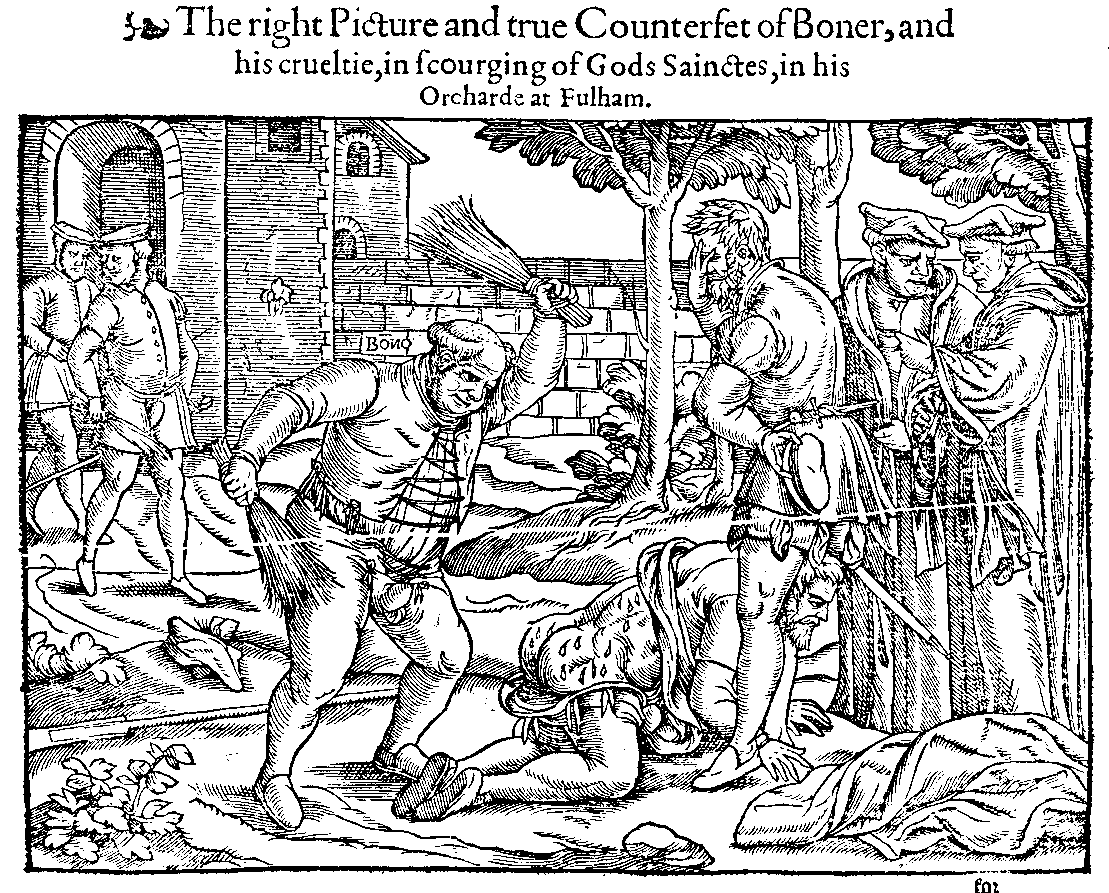1963 [1936]
Q. Mary. Vj. Martyrs burned at Brainford.
MarginaliaAnno. 1558. Iuly.cordingly was accomplished in the same place, the sayd xiiij. day of Iuly: Wherunto they being brough, made
MarginaliaThe Martyrdome of Robert Milles, Ste. Cotton. Rober Dynes, Ste. Wight, Iohn Slade. Will. Pikes, at Brainford. Anno 1558. Iuly 14.The burnyng of sixe Martyrs at Brainford.
 [View a larger version]
[View a larger version]
Commentary on the Woodcuts

The fifth use of this cut in the last two books in 1583.
their humble prayers vnto the Lord Iesus, vndressed themselues, went ioyfully to the stake wherto they were boūd, and the fire flaming about them, they yelded their
soules, bodies, and liues into the handes of the omnipotent Lord, for whose cause they did suffer, & to whose protection I commend thee gentle reader, Amen.
Among these vi. was one Williā Pikes (as ye haue heard) who sometyme dwelt in Ipswich in Suffolke, by his occupation a Tanner, a very honest godly man, and of a vertuous disposition, a good keeper of hospitalitie, and beneficiall to the persecuted in Q. Maries daies. This said William Pikes, in the 3. yeare of Q. Maries reigne,
Commentary

Pikes, or Pickess, had been forced to flee Ipswich before May 1556: see 1576, p. 1981 and 1583, p. 2089.
a little after Midsomer, beyng then at liberty, went into his Garden, and tooke with hym a Bible of Rogers translation, where he sitting with his face towardes the South, reading on the said Bible, sodenly fel doune vpon his boke betwene a. xi. and xii. a clocke of the day, iiij. droppes of fresh bloude, and hee knew not frō whence it came. Then he seyng the same, was sore astonished, and could by no meanes learne (as I said from whence it should fall: and wiping out one of the drops with his finger, called his wife, and said: In the vertue of God wife, what meaneth thys? will the Lord haue iiij. sacrifices? I see well enough the Lord will haue blood: his will be done, and geue mee grace to abide the triall. Wife, let vs pray (said he) for I feare the day draweth nigh. Afterward he dayly looked to be apprehēded of the papistes, & it came to passe accordingly, as ye haue heard. Thus much thought I good to write hereof, to stir vp our dull senses in considering þ
e Lords works, & reuerently to honor the same. His name therefore be praised for euermore, Amen.
[Back to Top]Moreouer, concernyng the said William Pikes, as he was in newgate sore sicke and at the point of death, so that no man looked he should liue vi. houres, there declared to them that stoode by, that he had bene twise in persecution before, & that now he desired the Lord, if it were his will, that he might glorifie his name at the stake, and so as he praied it came to passe at Brainford.
[Back to Top]Ye heard before of those 22. taken at Islington 13. were burned, and 6. escaped, albeit very hardly, and some of them not without scourgyng by the handes of the Bishop. In the which number was Thomas Hinshaw and Iohn Milles, accordyng to the expresse Picture, here after purported.
¶ The right Picture and true counterfeite of Boner, and his crueltie, in scourgyng of Gods Sainctes in his Orchard at Fulham.
 [View a larger version]
[View a larger version]
Commentary on the Woodcuts

Bishop Bonner (who perhaps scarcely needed the label attached to his garden wall in this woodcut) is particularly vivid in his characterisation here as the fat unlaced figure of ridicule acting as master of devilish ceremony. There was no mistaking his outrageousness, as he beat the prisoner John Willes so hard that he wore out his willow scourge and turned to a birch one, drawing so much blood that even his attendants recoiled. This was a device used elsewhere by the illustrators, and here all eyes are averted from Bonner's actions - the two clerks confer on their own, the servants coming in with a fresh birch whip turn away, and the man whose job it is to hold down the unfortunate prisoner covers his eyes. Bonner, who died in 1569, was still alive when the first edition of the Acts and Monuments appeared, and according to John Harington's later story, when shown his picture in the work laughed and said, 'a vengeance on the foole, how could he get my picture drawn so right?' In conflating the accounts of this episode in the text the illustrators took some liberties, for instance with the 'lad' bringing the new birch rod, and the victim, Thomas Hinshaw - reported as aged 19 or 20 - both of whom appear older. They were ready to rise above the specifics of textual fidelity in order to produce an image of Bonner's personal cruelty on a par with the corporate cruelties of the persecuting 'true Catholic Church of Christ' (represented in the first woodcut of 'The Proud Primacy of Popes' series, 1570, sig. nnir; 1576, p. 756; 1583, 780. Play on Bonner's name added to the visual exploitation of his character. What good qualities could be found in this bishop who combined the role of ruthless persecutor with the rauncy as well as the pauncy Vice of old comedy fame? The point was made in a simple pun. 'Boner' for Bonner ('Bono' inscribed on the wall behind him - very much the contrary of its Latin meaning (bonus, good).
¶ Ex


 1576 Edition | Book 12 | Page 1963
1576 Edition | Book 12 | Page 1963 